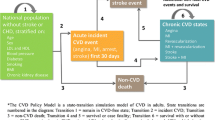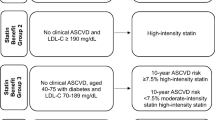Abstract
Objective
To contain costs, the US Department of Defense instituted a mandated statin formulary conversion program, designating cerivastatin and simvastatin as the ‘preferred statins’. This study examines the effectiveness, safety, and statin cost effectiveness following conversion to cerivastatin and simvastatin.
Design
Retrospective analysis.
Setting
Madigan Army Medical Center (MAMC), Tacoma, Washington, USA.
Patients
Men and women treated and filling their statin prescriptions at MAMC with records of statin conversion between October 1999 and April 2000 (n = 1303).
Methods
Age, gender, and lipid parameter measurements assessed pre-conversion (earliest measurement prior to conversion) and ≥21 days post-conversion were recorded. Pre- and post-conversion attainment of National Cholesterol Education Program Adult Treatment Panel II (NCEP-ATP H)/American Diabetes Association (ADA) goals, lipid parameters, and estimated statin cost per patient attaining NCEP-ATP II/ADA goals, were analysed.
Results
Conversion to cerivastatin (n = 1038) elevated goal attainment (18.2%), and reduced low-density lipoprotein and cholesterol (LDL-C) levels by 15.4 mg/dl, total cholesterol (TC) by 13.5 mg/dl and triglycerides (TG) by 10.2 mg/dl, and elevated high-density lipoprotein and cholesterol (HDL-C) levels by 3.8 mg/dl (all p < 0.002). Similar results occurred in NCEP-ATP II patient subgroups [secondary prevention; primary prevention: with diabetes mellitus, ≥2 risk factors (RF), and <2 RF]. Patients receiving simvastatin (n = 265) exhibited improvement in NCEP-ATP II/ADA goal attainment and LDL-C, TC, and HDL-C levels [all p < 0.05, except HDL-C in the <2 RF subgroup (nonsignificant)]. The estimated pre-conversion annual pharmacy statin cost per patient attaining and NCEP-ATP II/ADA goals was $US681 ($US56.77 per patient per month), compared with the post-conversion annual cost of $US355 ($US29.62 per patient per month), driven primarily by the cerivastatin conversion (2000 values). Post-conversion adverse events [rash (n = 3), dizziness (n = 1), and gastrointestinal upset (n = 1)] were rare. There were no reported clinically significant elevations of liver function tests or creatine kinase, or cases of myositis or myalgia.
Conclusions
Statin conversion at MAMC to cerivastatin and simvastatin is an effective and well tolerated method for improving NCEP-ATP II/ADA goal attainment and lipid parameters while containing pharmacy costs.








Similar content being viewed by others
References
American Heart Association. 2000 Heart and Stroke Statistical Update. Dallas (TX): American Heart Association, 1999
Caro J, Klittich W, McGuire A, et al. The West of Scotland coronary prevention study: economic benefit analysis of primary prevention with pravastatin. BMJ 1997; 315(7122): 1577–82
Johannesson M, Jonsson B, Kjekshus J, et al. Cost effectiveness of simvastatin treatment to lower cholesterol levels in patients with coronary heart disease. Scandinavian Simvastatin Survival Study Group. N Engl J Med 1997; 336(5): 332–6
Ganz DA, Kuntz KM, Jacobson GA, et al. Cost-effectiveness of 3-hydroxy-3-methylglutaryl coenzyme A reductase inhibitor therapy in older patients with myocardial infarction. Ann Intern Med 2000; 132(10): 780–7
Koren MJ, Smith DG, Hunninghake DB, et al. The cost of reaching National Cholesterol Education Program (NCEP) goals in hypercholesterolaemic patients. A comparison of atorvastatin, simvastatin, lovastatin and fluvastatin. Pharmacoeconomics 1998; 14(1): 59–70
Lin JC, Ito MK, Stolley SN, et al. The effect of converting from pravastatin to simvastatin on the pharmacodynamics of warfarin. J Clin Pharmacol 1999; 39(1): 86–90
Rindone JP, Arriola G. Conversion from fluvastatin to simvastatin therapy at a dose ratio of 8 to 1: effect on serum lipid levels and cost. Clin Ther 1998; 20(2): 340–6
Moisan J, Vaillancourt R, Gregoire JP, et al. Preferred hydroxymethylglutaryl-coenzyme A reductase inhibitors: treatment-modification program and outcomes. Am J Health Syst Pharm 1999; 56(14): 1437–41
Patel RJ, Gray DR, Pierce R, et al. Impact of therapeutic interchange from pravastatin to lovastatin in a Veterans Affairs Medical Center. Am J Manag Care 1999; 5(4): 465–74
Korman L, Borysiuk L. Replacing lovastatin with pravastatin: effect on serum lipids and costs. Am J Health Syst Pharm 1995; 52(10): 1078–82
Department of Defense/Pharmacy and Therapeutics Committee. Implementation guidance for HMG-CoAreductase inhibitors (’statins’) 1999 [online]. Available from URL: http://www.pec.ha.osd.mil/Contracts/statn_guid.htm [Accessed 2000 Dec 7]
American Diabetes Association. Management of dyslipidemia in adults with diabetes. Diabetes Care 2000; 23 Suppl. 1: S57–60
Summary of the second report of the National Cholesterol Education Program (NCEP) Expert Panel on Detection, Evaluation, and Treatment of High Blood Cholesterol in Adults (Adult Treatment Panel II). JAMA 1993; 269 (23): 3015–23
Friedewald WT, Levy RI, Fredrickson DS. Estimation of the concentration of low-density lipoprotein cholesterol in plasma, without use of the preparative ultracentrifuge. Clin Chem 1972; 18: 499–502
Insull Jr W, Isaacsohn J, Kwiterovich P, et al. Efficacy and safety of cerivastatin 0.8 mg in patients with hypercholesterolaemia: the pivotal placebo-controlled clinical trial. J Int Med Res 2000; 28(2): 47–68
Pagand M, Gauvreau K. Principles of bio statistics. Belmont (CA): Duxbery Press, 1992
Pearson TA, Laurora I, Chu H, et al. The lipid treatment assessment project (L-TAP): a multicenter survey to evaluate the percentages of dyslipidemic patients receiving lipid-lowering therapy and achieving low-density lipoprotein cholesterol goals. Arch Intern Med 2000; 160(4): 459–67
Danias PG, Os’ Mahony S, Radford MJ, et al. Serum cholesterol levels are underevaluated and undertreated. Am J Cardiol 1998; 81(11): 1353–6
Dujovne CA, Knopp R, Kwiterovich P, et al. Randomized comparison of the efficacy and safety of cerivastatin and pravastatin in 1,030 hypercholesterolemic patients. The Cerivastatin Study Group. Mayo Clin Proc 2000; 75(11): 1124–32
Hunninghake D, Dujovne C, Stein E, et al. The 0.4 mg dose of cerivastatin: comparative safety and efficacy of cerivastatin 0.3 mg vs fluvastastin 40 mg. Pharmacotherapy 1999; 19(10): 1194
Ose L, Luurila O, Eriksson J, et al. Efficacy and safety of cerivastatin, 0.2 mg and 0.4 mg, in patients with primary hypercholesterolaemia: a multinational, randomised, double-blind study. Cerivastatin Study Group. Curr Med Res Opin 1999; 15(3): 228–40
Hanefeld M, Deslypere JP, Ose L, et al. Efficacy and safety of 300 micrograms and 400 micrograms cerivastatin once daily in patients with primary hypercholesterolaemia: a multi-centre, randomized, double-blind, placebo-controlled study. J Int Med Res 1999; 27(3): 115–29
Brewer T, Colditz GA. Postmarketing surveillance and adverse drug reactions: current perspectives and future needs. JAMA 1999; 281(9): 824–9
Acknowledgements
This study was supported in part by the Bayer Corporation. The authors would like to thank Paul Cislo, MS for his valuable assistance in data management and programming, Kenneth Pomerantz, PhD for his insightful comments, and William W. Stark Jr, PhD, and Giovanna Devercelli, MBA, for significant input into manuscript development.
The views expressed in this manuscript are those of the authors and do not reflect the official policy or position of the Department of the Army, Department of Defense, or the United States Government.
Author information
Authors and Affiliations
Corresponding author
Rights and permissions
About this article
Cite this article
Beaudoin, D., Spaar, E., Lowenthal, S.P. et al. Increased National Cholesterol Education Program (NCEP) Goal Attainment. Dis-Manage-Health-Outcomes 9, 699–709 (2001). https://doi.org/10.2165/00115677-200109120-00004
Published:
Issue Date:
DOI: https://doi.org/10.2165/00115677-200109120-00004




